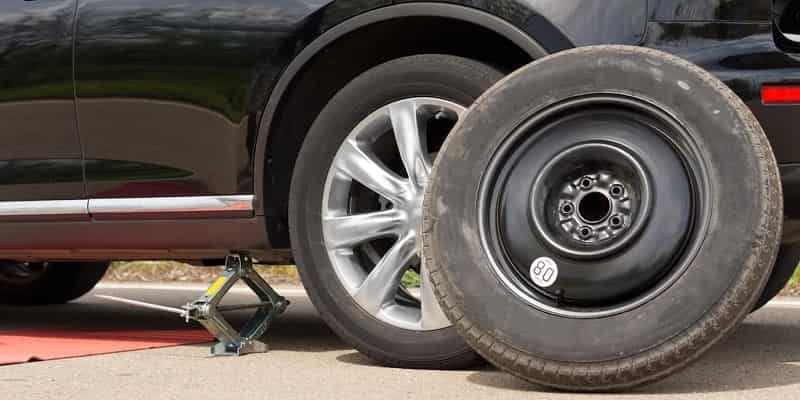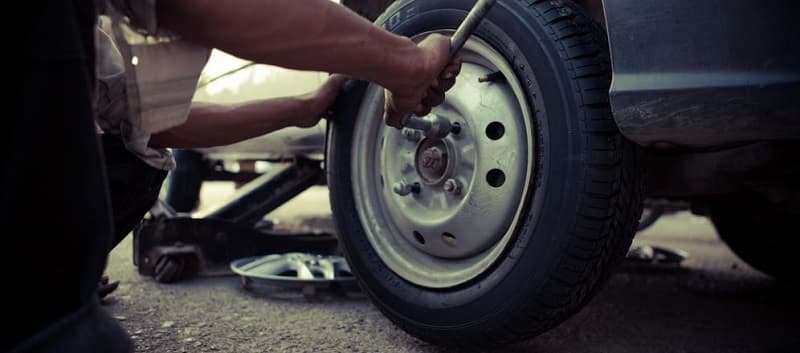Although tires can withstand many effects such as wear and tear, they can puncture or burst. With a spare tire, the distance you can travel is limited. How long can you drive on a spare tire?

How long can you drive on a spare tire?
Contents
- Driving with a spare tire: New driving conditions
- How long can you drive on a spare tire?
- What maximum speed with a spare tire?
- What precautions should we take when driving with a spare tire?
- What you should know about the spare tire?
- The tire pressure of the spare tire
- Driving with a spare tire: Practical advice
- FAQs
- Conclusion
Driving with a spare tire: New driving conditions
Using a temporary spare tire affects driving conditions. It reduces the handling of the vehicle, the steering, braking, and suspension functions. The stability of the undercarriage on which it mounted the space saver can also be affected.
Because of the differences in size and inflation pressure between a full-size wheel and space- saver wheel, some driver help and active safety systems such as ABS and ESP. For example, they do not work correctly when a space saver wheel is fitted to the vehicle. It is necessary to be extra vigilant, especially on a winding or degraded road.
How long can you drive on a spare tire?
The spare wheel must be used temporarily. It is essential to repair the flat tire or to change it as soon as possible. The maximum distance to be covered with a space saver varies from one manufacturer to another. How far can you drive on a spare tire? And, it is usually around 50 miles.
Recognizable by its size and the “T” which means “temporary”, spare tires precede the dimensions of the wheel. The disc offers advantages whether in terms of cost, space, or practicality. It only allows you to replace your main wheel in the event of a puncture or burst.
Provisional, it is advisable to drive as short as possible with this tire. On average, the spare tire can be available for 50 miles or even 70 miles. There are several reasons you should not drive too much with this spare tire:
- Driving conditions can be deleterious
- It limits your speed
- We must take precautions
- It reduces your handling
- Tire pressure is uneven
- The tire pad inflation is not identical to that of other tires
What maximum speed with a spare tire?

Given the structure and the small size of this spare tire, the temporary spare tire limits the speed of your vehicle. As being less robust than a regular one, these spare tires cannot withstand excessively high speeds. It is the reason to go to the nearest garage if you have a flat tire.
Because of its small size and structure, the spare wheel is less robust than a full-size wheel. Therefore, it cannot withstand top speeds. Almost all manufacturers recommend driving at a speed below 50 mph when using a temporary spare tire. In principle, the maximum recommended speed is on the sidewall of the tire or a label affixed to the rim.
Automakers advise motorists to keep staying below 50 mph. Otherwise, the maximum speed supported by these spare wheels is normally indicated on the sidewall or a label affixed to the rim.
If you do not exceed a certain speed, you can continue to drive beyond 50 miles. The spare tire can last up to 70 miles if you do not put too much strain on it. However, consider inflating it regularly. The pressure loss on a wafer is greater than on the base tires.
In the event of rain, do not drive at 50 mph. You can prefer to drive at 30 mph - 40 mph. Besides having a limited adhesion, the space safer is less wide than a complete wheel and favors the imbalance of the vehicle.
What precautions should we take when driving with a spare tire?
If you have to change the wheel of your car for a disc, be aware that your driving conditions will be impacted. Whether in terms of vehicle handling, braking, balancing, or suspensions, the sensations are not the same. It is why you need to have your spare tire repaired as soon as possible.
What you should know about the spare tire?
- Never drive with over one spare-saving, a spare tire affects your driving.
- Be careful when rolling with a pancake. The presence of a spare tire makes your driving more irregular and affects your parallelism.
- Regularly check the pressure of your spare tire: monitoring the pressure of your spare tire is essential to avoid damaging it.
- If you are in a mountainous region, be aware that we cannot fit a galette with chains.
The tire pressure of the spare tire
We should inflate the space-saver spare tire to the highest pressure recommended for the different wheel/tire size combinations. For passenger cars, manufacturers recommend a pressure of 4.2 bar.
Driving with a spare tire: Practical advice
The spare wheel is a temporary spare tire. It should be available temporarily and replaced as soon as possible with a full-size wheel.
The size of the spare wheel tire is smaller than a normal tire. Its pressure is higher. When you ride with a space saver wheel, the ride becomes more uneven. On an SUV like Kia Sorento or Kia Sportage, traction could be reduced on certain surfaces. So be careful!
- Never use over spare tire at the same time at many wheels as it can seriously affect the stability and handling of your vehicle.
- Regularly check your spare tire and make sure the tread is free from damage.
- Never drive your vehicle faster than 70 miles when using a temporary spare tire.
- Check that the inflation pressure complies with the manufacturer's recommendations. It is advisable to check the pressure of the spare wheel to avoid unpleasant surprises.
- The life of a spare tire is shorter than a full-size tire. So remember to replace the spare wheel tire in the event of wear or damage. The new tire must have the same characteristics and specifications as the used tire.
- Finally, note that we cannot fit a temporary spare tire with snow chains.
FAQs
Is the spare tire compulsory?
You will surely be amazed, but the answer is no. Unlike the warning triangle or the safety vest, the law does not require you to have a recovery wheel. However, like the jack or the tire sealant, the spare tire is an accessory to have in your car. Thanks to it, you can avoid paying a small fortune by having to call a mechanic.
Where is your spare tire located?
In the event of a flat tire or a deflated tire, you may have to replace the wheel yourself. If you have a puncture with one of your conventional tires, the location of the spare tire is variable. Depending on the vehicle model (SUV, Berlin, sport, etc.), space may be:
- Under the hood
- On the trunk door
- Under the vehicle
To reduce vehicle fuel consumption, the vast majority of newer cars are no longer equipped with a spare wheel. Therefore, it is up to you to buy a replacement tire to repair a puncture quickly. You can also buy additional equipment like a tire iron, preventive fluid, a repair kit, or an anti-puncture kit to reduce the risk of a puncture.
Otherwise, there are other solutions. You can opt for a puncture-proof tire, bombs, anti-puncture fluid, or wicks in case of a slow puncture. Although it is not mandatory, the spare tire is an accessory that can save you significant repair costs. When riding with a spare tire, be sure to re-inflate it to check the pressure level. A pressure of 4.2 bar is ideal to ride in complete safety.
Conclusion
The traditional full-size spare tire / spare wheel has almost disappeared, by replacing the full-size wheel with a space-saver spare wheel, and today's replacements are enough to drive your spare. It is a temporary spare wheel recognizable by the “T” (for temporary) that precedes the dimensions shown on the sidewall of the tire. The spare wheel offers undeniable advantages in terms of cost, size, weight, and practicality of use. However, it requires more attention than the other wheels of the full-size vehicle. This article has shown you some precautions to take and some practical advice on how to use a spare tire.
I’m Ivo Gievski, the content writer for Tireer. We built our website with over 15 years of experience and extensive research in the automotive and technology sectors. My dedication to delivering high-quality content is unwavering, and I strive to continuously hone my skills to stay ahead of industry trends and provide readers with informative, engaging, and valuable insights.